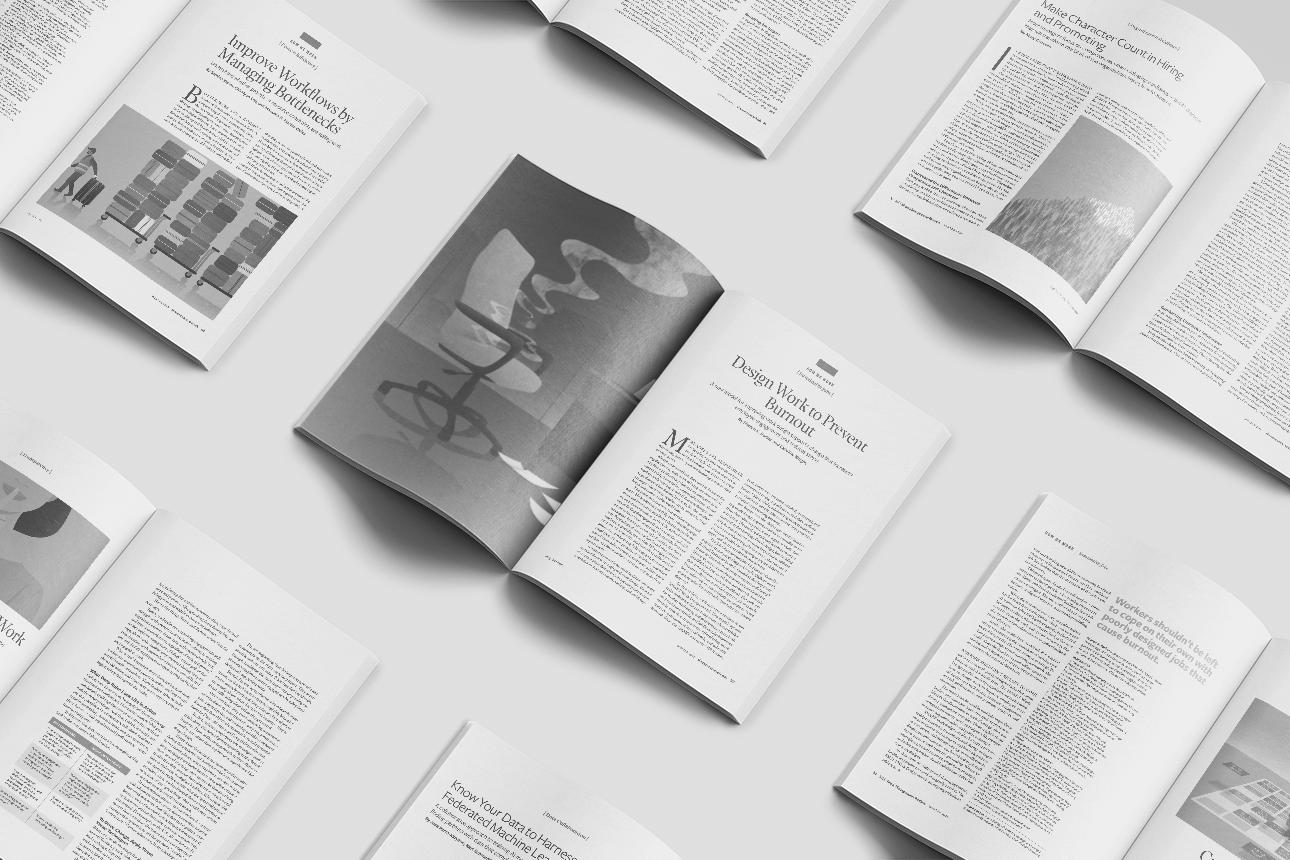Design Work to Prevent Burnout
Sharon K. Parker and Caroline Knight
Key Insight: Managers can apply a new model for work design to enhance their teams’ well-being and engagement by improving key job characteristics.
Top Takeaways: Maintaining employee morale and keeping productivity high are just two of managers’ myriad responsibilities. But reducing burnout and improving worker well-being in order to meet those challenges is a struggle for many leaders. Fix-the-worker approaches don’t address root problems like long hours and unreasonable workloads. To increase employee engagement and reduce burnout, managers can apply a new model for improving work design that emphasizes stimulating work, mastery, autonomy, relational work, and tolerable demands.
Craft Schedules That Work for Everyone
Donald Sull and Alexander Kowalski
Key Insight: Rethinking poor scheduling practices that are affecting workers’ well-being and performance can ultimately benefit both employees and the business.
Top Takeaways: The work schedules employers impose on their employees have a significant impact on workers’ energy, enthusiasm, and commitment to their jobs. Effective schedules take into account employees’ diverse needs as well as the business’s. Flexibility and predictability in scheduling, reasonable hours, and time off are all ways to enhance retention and improve worker productivity. The authors share five recommendations to help managers craft effective schedules, along with the distinct dimensions of schedules that matter most to workers.
Improve Workflows by Managing Bottlenecks
Samina Karim, Chi-Hyon Lee, and Manuela N. Hoehn-Weiss
Key Insight: Well-designed work systems and resource portfolios can help companies address choke points that are hindering their organizational performance.
Top Takeaways: When organizations’ activities are slowed by bottlenecks in their workflows, managers must assess both their resource portfolios and work system design. New research finds that companies better manage task bottlenecks when their work systems have low complexity and centralized workflows, or high complexity and decentralized workflows. Likewise, they can improve system performance by better aligning their fungible and slack resources. Aligning both task and resource characteristics further reduces delays and improves organizational efficiency.
A Practical Guide to Gaining Value From LLMs
Rama Ramakrishnan
Key Insight: Leaders should conduct a comprehensive cost-benefit analysis on generative AI use cases before building and deploying applications that use large language models (LLMs).
Top Takeaways: A number of companies have made significant investments in generative AI tools, particularly those using LLMs, but many of them have found returns on that spending to be elusive. LLMs’ costs, risks, and limitations must be carefully weighed against their potential to increase the efficiency of business processes before they advance to the pilot or implementation stage. The author shares an approach to identifying tasks that are likely to have a favorable risk-reward ratio, as well as techniques for adapting off-the-shelf LLMs for specific tasks.
The Myth of the Sustainable Consumer
Andreas von der Gathen, Nicolai Broby Eckert, and Caroline Kastbjerg
Key Insight: New insights into consumers’ commitment to and willingness to pay for sustainable products could translate into business growth opportunities.
Top Takeaways: Many consumers have moved toward making more sustainable purchasing decisions. However, the common misconception that only one type of sustainable consumer exists — one who is all-in on sustainable goods and services and willing to pay higher prices for them — limits companies’ approach to targeting potential new customers. Through their analysis of two studies, researchers were able to segment consumers into eight distinct archetypes based on their commitment to sustainable purchases and willingness to pay a premium for them. Understanding these archetypes can help companies pursue exceptional growth while offering sustainable solutions.
How Integrating DEI Into Strategy Lifts Performance
Quinetta Roberson
Key Insight: Companies whose diversity, equity, and inclusion efforts incorporate DEI strategy, governance, and goals and tracking tend to see more financial rewards.
Top Takeaways: Amid political pushback against DEI, evidence continues to mount that a well-implemented diversity, equity, and inclusion practice can have a positive impact on a company’s bottom line. In a recent study of credit unions, better results on some financial measures, including return on assets and net income, were associated with three sets of actions: integrating DEI practices into organizationwide strategy, using multiple tactics to achieve specific goals, and tracking goals and DEI metrics to support continuous improvement. The author shares actions organizations can take to integrate DEI into their business strategy.
Know Your Data to Harness Federated Machine Learning
José Parra-Moyano, Karl Schmedders, and Maximilian Werner
Key Insight: Organizations can improve their algorithms by sharing their data using the privacy-preserving technique of federated learning.
Top Takeaways: Many companies lack enough of their own high-quality data to train and fine-tune their AI models. Federated learning can help organizations address the problem by enabling them to use one another’s data sets to train their algorithms while maintaining the privacy of each partner’s proprietary data. It does this through a decentralized approach in which the algorithm is sent to each data source rather than requiring partners to release their data. The authors suggest strategies for finding suitable federated learning partners — across or within industries — based on the type and quality of your organization’s data.
Why Influence Is a Two-Way Street
Jonathan Hughes, Jessica Wadd, and Ashley Hetrick
Key Insight: A collaborative model of influence that prioritizes making the best decision for the organization over selling a personal perspective often yields better results.
Top Takeaways: The ability to wield influence is important for meeting team and individual goals in highly matrixed organizations, but an overemphasis on selling one’s own point of view can hamstring good decision-making. The authors make a case for fostering a culture of collaborative influence, where people engage in joint problem-solving to arrive at the best decision for the organization. They also share research-based advice on how managers can steer the culture toward this give-and-take approach to persuasion.
Make Character Count in Hiring and Promoting
Mary Crossan
Key Insight: Considering character as well as competence in hiring can ultimately lead to a healthier culture and a competitive advantage for companies.
Top Takeaways: Organizational culture reflects the characteristics of the people a company hires. So organizations that focus chiefly on competencies in hiring or tend to select candidates with specific dimensions of character to the exclusion of others risk bringing toxicity and poor judgment into the fold. Research has identified a set of 11 dimensions of character that can manifest as strengths when they complement one another or weaknesses when out of balance. Leaders can learn how to assess the character of potential hires or promotion candidates and identify individuals whose traits can enhance the organizational culture or be further developed to make them stronger contributors.
“The MIT Sloan Management Review is a research-based magazine and digital platform for business executives published at the MIT Sloan School of Management.”
Please visit the firm link to site






